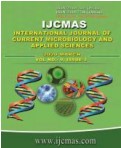


 National Academy of Agricultural Sciences (NAAS)
National Academy of Agricultural Sciences (NAAS)

|
PRINT ISSN : 2319-7692
Online ISSN : 2319-7706 Issues : 12 per year Publisher : Excellent Publishers Email : editorijcmas@gmail.com / submit@ijcmas.com Editor-in-chief: Dr.M.Prakash Index Copernicus ICV 2018: 95.39 NAAS RATING 2020: 5.38 |
Fungal infections or mycoses are classified as Superficial, Subcutaneous, and Systemic depending on the degree of invasion of the host. Superficial fungal infections are most common in tropical and subtropical countries. Superficial fungal infections of the skin are one of the most common dermatological conditions seen in clinical practice. It affects 20-25% of the population. In this study, 1473 Suspected superficial fungal infection cases were identified among approximately 3500 patients screened during August 2017 to August 2019. The collected samples (skin, nail, and hair) were subjected to direct microscopy with 10% potassium hydroxide and cultured on plain Sabourauds dextrose agar, Sabourauds dextrose agar with actidione and Sabourauds dextrose agar with chloramphenicol. After the fungal culture growth Lacto Phenol Cotton Blue mount was done to identify the fungal species. The prevalence of superficial fungal infection was 26.2% (386/1473), dermatophytosis was 63.7% (246/386), and non-dermatophytosis was 36.3% (140/386). Among the isolated dermatophytes, Trichophyton rubrum was the commonest species (68%). and Candida (70%) the commonest non-dermatophytes species. Tinea corporis wasthe commonest (58%) clinical presentation. Culture examination highlighted dermatophytes 68%Trichophyton rubrum, 19% Trichophytonmentagrophyte, 6% Trichophyton tonsurans, 2% Trichophyton violaceum, 2% Microsporum gypseum,, 1.5% Microsporum canis, 0.9% Trichophyton verrucosum 0.5% Epidermophyton floccosumand non-dermatophytes 38% Candida albicans, 32% Candida non albicans 10% Aspergillus niger, 7% Aspergillus flavus, 4% Aspergillus fumigatus, 1% Aspergillus ptereus, 3.5% Malassezia furfur, 2% Alternaria, 2% Curvularia and 0.5% Cladosporium werneckii. The current study illustrates that a notable number of patients had prevalence of superficial fungal infections, hence a prompt recognition of skin lesion and identification of these superficial fungal infections alarms us to undertake early diagnosis and treatment to improve the quality of life.
 |
 |
 |
 |
 |